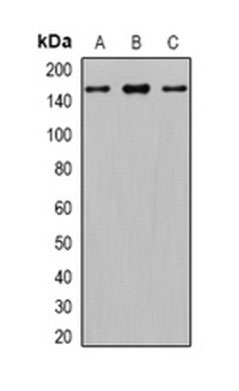Anti-GLI1 Antibody
- 产品详情
- 实验流程
Application
| WB |
|---|---|
| Primary Accession | P08151 |
| Reactivity | Human, Mouse, Rat |
| Host | Rabbit |
| Isotype | Rabbit IgG |
| Calculated MW | 117904 Da |
| Gene ID | 2735 |
|---|---|
| Positive Control | WB: PC3, mouse barin, rat brain lysates |
| Application & Usage | WB; 1:500 – 1:2000 |
| Other Names | s GLI; Zinc finger protein GLI1; Glioma-associated oncogene; Oncogene GLI |
| Target/Specificity | GLI1 |
| Antibody Form | Liquid |
| Appearance | Colorless liquid |
| Handling | The antibody solution should be gently mixed before use |
| Reconstitution & Storage | -20°C |
| Background Descriptions | |
| Precautions | Anti-GLI1 Antibody is for research use only and not for use in diagnostic or therapeutic procedures. |
| Name | GLI1 |
|---|---|
| Synonyms | GLI |
| Function | Acts as a transcriptional activator (PubMed:10806483, PubMed:19706761, PubMed:19878745, PubMed:24076122, PubMed:24217340, PubMed:24311597). Binds to the DNA consensus sequence 5'-GACCACCCA-3' (PubMed:2105456, PubMed:24217340, PubMed:8378770). Regulates the transcription of specific genes during normal development (PubMed:19706761). Plays a role in craniofacial development and digital development, as well as development of the central nervous system and gastrointestinal tract. Mediates SHH signaling (PubMed:19706761, PubMed:28973407). Plays a role in cell proliferation and differentiation via its role in SHH signaling (PubMed:11238441, PubMed:28973407). |
| Cellular Location | Cytoplasm. Nucleus. Note=Tethered in the cytoplasm by binding to SUFU (PubMed:10806483). Activation and translocation to the nucleus is promoted by interaction with STK36 (PubMed:10806483). Phosphorylation by ULK3 may promote nuclear localization (PubMed:19878745). Translocation to the nucleus is promoted by interaction with ZIC1 (PubMed:11238441) |
| Tissue Location | Detected in testis (at protein level) (PubMed:2105456). Testis, myometrium and fallopian tube. Also expressed in the brain with highest expression in the cerebellum, optic nerve and olfactory tract (PubMed:19878745). Isoform 1 is detected in brain, spleen, pancreas, liver, kidney and placenta; isoform 2 is not detectable in these tissues (PubMed:19706761) |
Research Areas
For Research Use Only. Not For Use In Diagnostic Procedures.
Application Protocols
Provided below are standard protocols that you may find useful for product applications.
终于等到您。ABCEPTA(百远生物)抗体产品。
点击下方“我要评价 ”按钮提交您的反馈信息,您的反馈和评价是我们最宝贵的财富之一,
我们将在1-3个工作日内处理您的反馈信息。
如有疑问,联系:0512-88856768 tech-china@abcepta.com.
Discontinued
Cat# ABV11955
Size:
100 µl
Price:
¥ 3,540.00
替代产品:























 癌症的基本特征包括细胞增殖、血管生成、迁移、凋亡逃避机制和细胞永生等。找到癌症发生过程中这些通路的关键标记物和对应的抗体用于检测至关重要。
癌症的基本特征包括细胞增殖、血管生成、迁移、凋亡逃避机制和细胞永生等。找到癌症发生过程中这些通路的关键标记物和对应的抗体用于检测至关重要。 为您推荐一个泛素化位点预测神器——泛素化分析工具,可以为您的蛋白的泛素化位点作出预测和评分。
为您推荐一个泛素化位点预测神器——泛素化分析工具,可以为您的蛋白的泛素化位点作出预测和评分。 细胞自噬受体图形绘图工具为你的蛋白的细胞受体结合位点作出预测和评分,识别结合到自噬通路中的蛋白是非常重要的,便于让我们理解自噬在正常生理、病理过程中的作用,如发育、细胞分化、神经退化性疾病、压力条件下、感染和癌症。
细胞自噬受体图形绘图工具为你的蛋白的细胞受体结合位点作出预测和评分,识别结合到自噬通路中的蛋白是非常重要的,便于让我们理解自噬在正常生理、病理过程中的作用,如发育、细胞分化、神经退化性疾病、压力条件下、感染和癌症。






